Free Breast Screening Program in Australia: A Comprehensive Report
VerifiedAdded on 2022/08/23
|14
|3300
|15
Report
AI Summary
This report examines the free breast screening program in Australia, a national health initiative aimed at the early detection and treatment of breast cancer through mammography every two years for women aged 40 and above. The report provides background information, the purpose and scope of the study, and discusses the health issue of breast cancer, including symptoms, causes, and preventative measures. It identifies the population at risk, particularly Indigenous Australians, and explores factors contributing to their higher risk. The report reviews relevant literature, analyzing incidence, survival rates, deaths, and new cases of breast cancer. It also highlights the critical roles nurses play in the screening process, including management, education, and health promotion. Statistical data from the past five years are analyzed to assess the program's effectiveness. The report concludes that the program has been successfully implemented and has helped to manage the incidence of breast cancer.
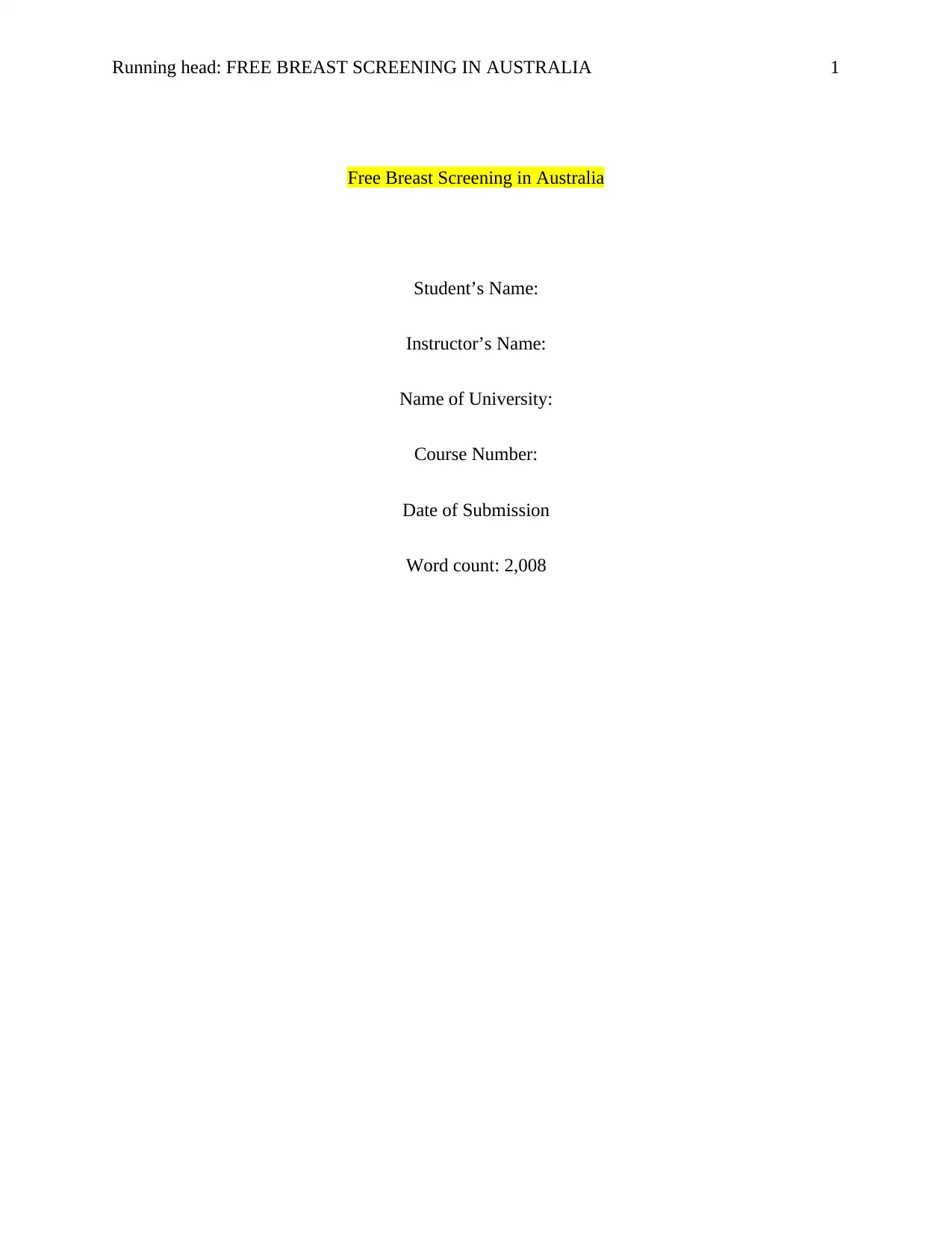
Running head: FREE BREAST SCREENING IN AUSTRALIA 1
Free Breast Screening in Australia
Student’s Name:
Instructor’s Name:
Name of University:
Course Number:
Date of Submission
Word count: 2,008
Free Breast Screening in Australia
Student’s Name:
Instructor’s Name:
Name of University:
Course Number:
Date of Submission
Word count: 2,008
Paraphrase This Document
Need a fresh take? Get an instant paraphrase of this document with our AI Paraphraser

FREE BREAST SCREENING IN AUSTRALIA i
Abstract
Free breast screening in Australia is a national health intervention that is aimed at detecting and
early treatment of breast cancer. The program is carried out once every two years. The objective
of this paper is to assess the status of free breast screening in Australia. Evidence-based literature
will also be examined to further explore the intervention. Breast cancer is a result of an abnormal
growth of breast cells leading to symptoms such as breast lump around the nipple of the breast,
disfiguration of the breast, changes in the skin color and an inverted nipple. Indigenous
Australians are the population at a higher risk of being diagnosed with the condition due to their
unhealthy lifestyle among other factors. The incidence, survival rate, death rate, and new cases of
breast cancer depict the magnitude of the disease and the significance of the free breast screening
initiative. Nurses as well play critical roles during the screening process namely management
and education and health promotion. Free breast screening program in Australia has successfully
been implemented and thus enabling the health sector to manage the incidence of breast cancer
i
Abstract
Free breast screening in Australia is a national health intervention that is aimed at detecting and
early treatment of breast cancer. The program is carried out once every two years. The objective
of this paper is to assess the status of free breast screening in Australia. Evidence-based literature
will also be examined to further explore the intervention. Breast cancer is a result of an abnormal
growth of breast cells leading to symptoms such as breast lump around the nipple of the breast,
disfiguration of the breast, changes in the skin color and an inverted nipple. Indigenous
Australians are the population at a higher risk of being diagnosed with the condition due to their
unhealthy lifestyle among other factors. The incidence, survival rate, death rate, and new cases of
breast cancer depict the magnitude of the disease and the significance of the free breast screening
initiative. Nurses as well play critical roles during the screening process namely management
and education and health promotion. Free breast screening program in Australia has successfully
been implemented and thus enabling the health sector to manage the incidence of breast cancer
i
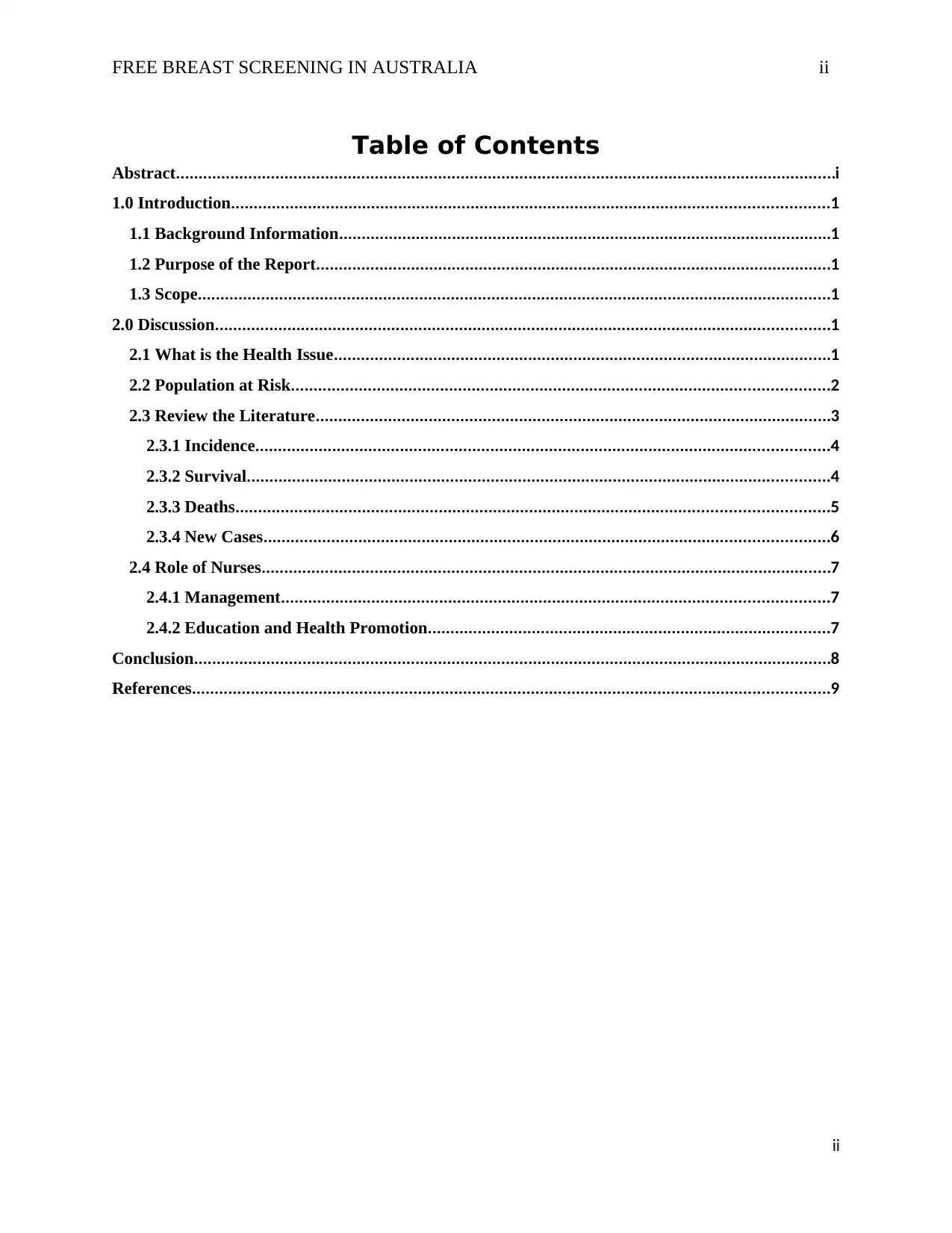
FREE BREAST SCREENING IN AUSTRALIA ii
Table of Contents
Abstract..................................................................................................................................................i
1.0 Introduction....................................................................................................................................1
1.1 Background Information.............................................................................................................1
1.2 Purpose of the Report..................................................................................................................1
1.3 Scope............................................................................................................................................1
2.0 Discussion........................................................................................................................................1
2.1 What is the Health Issue..............................................................................................................1
2.2 Population at Risk.......................................................................................................................2
2.3 Review the Literature..................................................................................................................3
2.3.1 Incidence...............................................................................................................................4
2.3.2 Survival.................................................................................................................................4
2.3.3 Deaths...................................................................................................................................5
2.3.4 New Cases.............................................................................................................................6
2.4 Role of Nurses..............................................................................................................................7
2.4.1 Management.........................................................................................................................7
2.4.2 Education and Health Promotion.........................................................................................7
Conclusion.............................................................................................................................................8
References.............................................................................................................................................9
ii
Table of Contents
Abstract..................................................................................................................................................i
1.0 Introduction....................................................................................................................................1
1.1 Background Information.............................................................................................................1
1.2 Purpose of the Report..................................................................................................................1
1.3 Scope............................................................................................................................................1
2.0 Discussion........................................................................................................................................1
2.1 What is the Health Issue..............................................................................................................1
2.2 Population at Risk.......................................................................................................................2
2.3 Review the Literature..................................................................................................................3
2.3.1 Incidence...............................................................................................................................4
2.3.2 Survival.................................................................................................................................4
2.3.3 Deaths...................................................................................................................................5
2.3.4 New Cases.............................................................................................................................6
2.4 Role of Nurses..............................................................................................................................7
2.4.1 Management.........................................................................................................................7
2.4.2 Education and Health Promotion.........................................................................................7
Conclusion.............................................................................................................................................8
References.............................................................................................................................................9
ii
⊘ This is a preview!⊘
Do you want full access?
Subscribe today to unlock all pages.

Trusted by 1+ million students worldwide
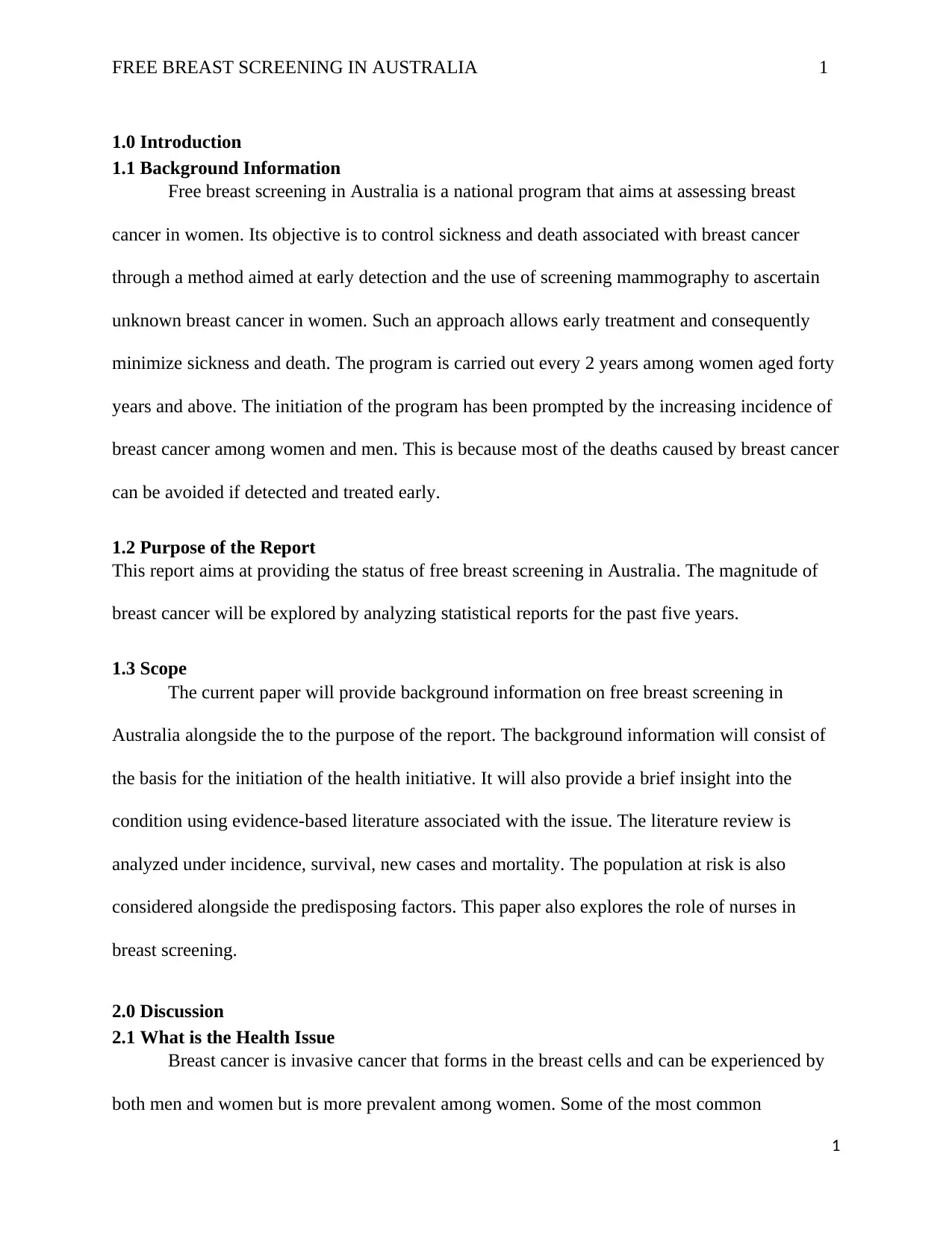
FREE BREAST SCREENING IN AUSTRALIA 1
1.0 Introduction
1.1 Background Information
Free breast screening in Australia is a national program that aims at assessing breast
cancer in women. Its objective is to control sickness and death associated with breast cancer
through a method aimed at early detection and the use of screening mammography to ascertain
unknown breast cancer in women. Such an approach allows early treatment and consequently
minimize sickness and death. The program is carried out every 2 years among women aged forty
years and above. The initiation of the program has been prompted by the increasing incidence of
breast cancer among women and men. This is because most of the deaths caused by breast cancer
can be avoided if detected and treated early.
1.2 Purpose of the Report
This report aims at providing the status of free breast screening in Australia. The magnitude of
breast cancer will be explored by analyzing statistical reports for the past five years.
1.3 Scope
The current paper will provide background information on free breast screening in
Australia alongside the to the purpose of the report. The background information will consist of
the basis for the initiation of the health initiative. It will also provide a brief insight into the
condition using evidence-based literature associated with the issue. The literature review is
analyzed under incidence, survival, new cases and mortality. The population at risk is also
considered alongside the predisposing factors. This paper also explores the role of nurses in
breast screening.
2.0 Discussion
2.1 What is the Health Issue
Breast cancer is invasive cancer that forms in the breast cells and can be experienced by
both men and women but is more prevalent among women. Some of the most common
1
1.0 Introduction
1.1 Background Information
Free breast screening in Australia is a national program that aims at assessing breast
cancer in women. Its objective is to control sickness and death associated with breast cancer
through a method aimed at early detection and the use of screening mammography to ascertain
unknown breast cancer in women. Such an approach allows early treatment and consequently
minimize sickness and death. The program is carried out every 2 years among women aged forty
years and above. The initiation of the program has been prompted by the increasing incidence of
breast cancer among women and men. This is because most of the deaths caused by breast cancer
can be avoided if detected and treated early.
1.2 Purpose of the Report
This report aims at providing the status of free breast screening in Australia. The magnitude of
breast cancer will be explored by analyzing statistical reports for the past five years.
1.3 Scope
The current paper will provide background information on free breast screening in
Australia alongside the to the purpose of the report. The background information will consist of
the basis for the initiation of the health initiative. It will also provide a brief insight into the
condition using evidence-based literature associated with the issue. The literature review is
analyzed under incidence, survival, new cases and mortality. The population at risk is also
considered alongside the predisposing factors. This paper also explores the role of nurses in
breast screening.
2.0 Discussion
2.1 What is the Health Issue
Breast cancer is invasive cancer that forms in the breast cells and can be experienced by
both men and women but is more prevalent among women. Some of the most common
1
Paraphrase This Document
Need a fresh take? Get an instant paraphrase of this document with our AI Paraphraser
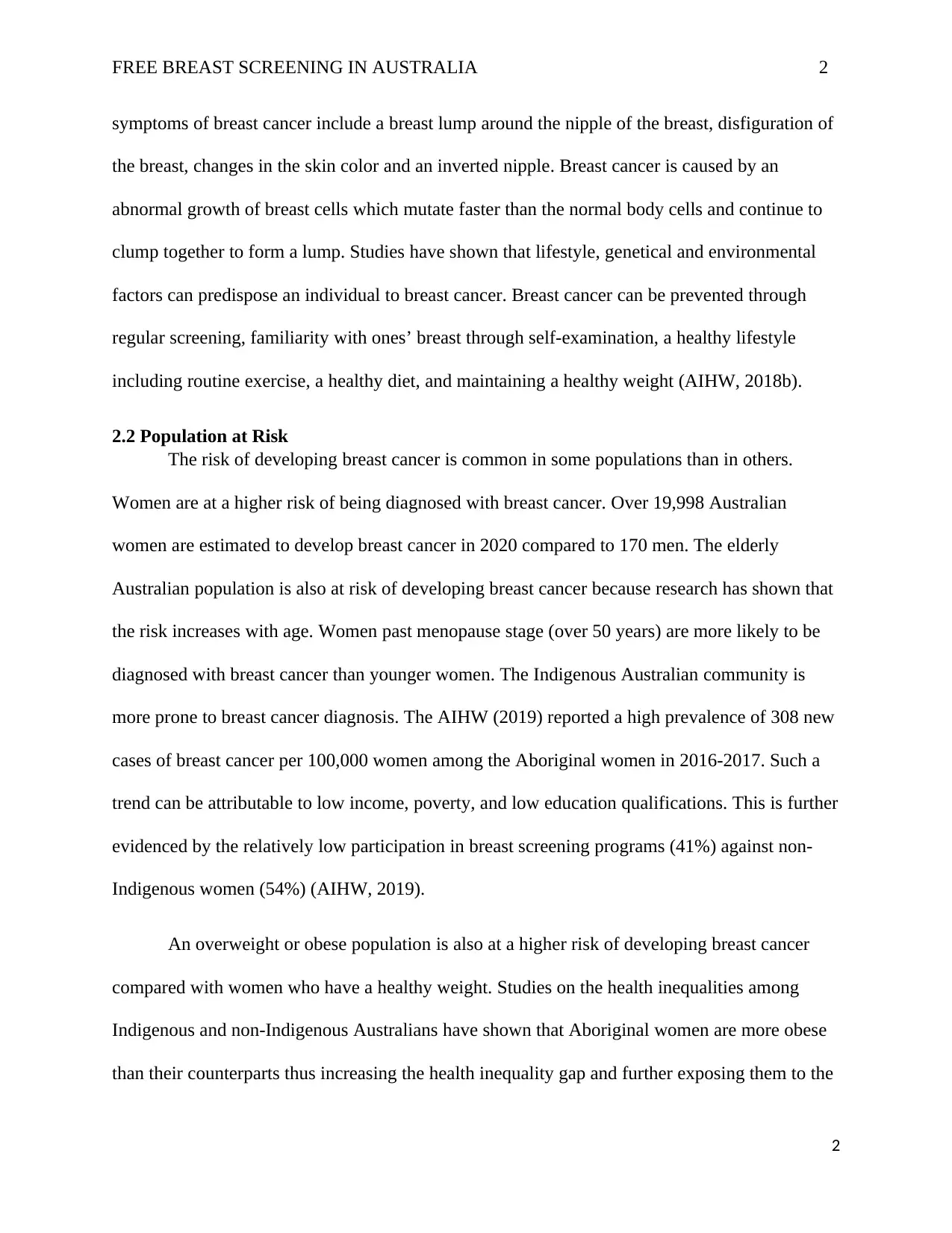
FREE BREAST SCREENING IN AUSTRALIA 2
symptoms of breast cancer include a breast lump around the nipple of the breast, disfiguration of
the breast, changes in the skin color and an inverted nipple. Breast cancer is caused by an
abnormal growth of breast cells which mutate faster than the normal body cells and continue to
clump together to form a lump. Studies have shown that lifestyle, genetical and environmental
factors can predispose an individual to breast cancer. Breast cancer can be prevented through
regular screening, familiarity with ones’ breast through self-examination, a healthy lifestyle
including routine exercise, a healthy diet, and maintaining a healthy weight (AIHW, 2018b).
2.2 Population at Risk
The risk of developing breast cancer is common in some populations than in others.
Women are at a higher risk of being diagnosed with breast cancer. Over 19,998 Australian
women are estimated to develop breast cancer in 2020 compared to 170 men. The elderly
Australian population is also at risk of developing breast cancer because research has shown that
the risk increases with age. Women past menopause stage (over 50 years) are more likely to be
diagnosed with breast cancer than younger women. The Indigenous Australian community is
more prone to breast cancer diagnosis. The AIHW (2019) reported a high prevalence of 308 new
cases of breast cancer per 100,000 women among the Aboriginal women in 2016-2017. Such a
trend can be attributable to low income, poverty, and low education qualifications. This is further
evidenced by the relatively low participation in breast screening programs (41%) against non-
Indigenous women (54%) (AIHW, 2019).
An overweight or obese population is also at a higher risk of developing breast cancer
compared with women who have a healthy weight. Studies on the health inequalities among
Indigenous and non-Indigenous Australians have shown that Aboriginal women are more obese
than their counterparts thus increasing the health inequality gap and further exposing them to the
2
symptoms of breast cancer include a breast lump around the nipple of the breast, disfiguration of
the breast, changes in the skin color and an inverted nipple. Breast cancer is caused by an
abnormal growth of breast cells which mutate faster than the normal body cells and continue to
clump together to form a lump. Studies have shown that lifestyle, genetical and environmental
factors can predispose an individual to breast cancer. Breast cancer can be prevented through
regular screening, familiarity with ones’ breast through self-examination, a healthy lifestyle
including routine exercise, a healthy diet, and maintaining a healthy weight (AIHW, 2018b).
2.2 Population at Risk
The risk of developing breast cancer is common in some populations than in others.
Women are at a higher risk of being diagnosed with breast cancer. Over 19,998 Australian
women are estimated to develop breast cancer in 2020 compared to 170 men. The elderly
Australian population is also at risk of developing breast cancer because research has shown that
the risk increases with age. Women past menopause stage (over 50 years) are more likely to be
diagnosed with breast cancer than younger women. The Indigenous Australian community is
more prone to breast cancer diagnosis. The AIHW (2019) reported a high prevalence of 308 new
cases of breast cancer per 100,000 women among the Aboriginal women in 2016-2017. Such a
trend can be attributable to low income, poverty, and low education qualifications. This is further
evidenced by the relatively low participation in breast screening programs (41%) against non-
Indigenous women (54%) (AIHW, 2019).
An overweight or obese population is also at a higher risk of developing breast cancer
compared with women who have a healthy weight. Studies on the health inequalities among
Indigenous and non-Indigenous Australians have shown that Aboriginal women are more obese
than their counterparts thus increasing the health inequality gap and further exposing them to the
2
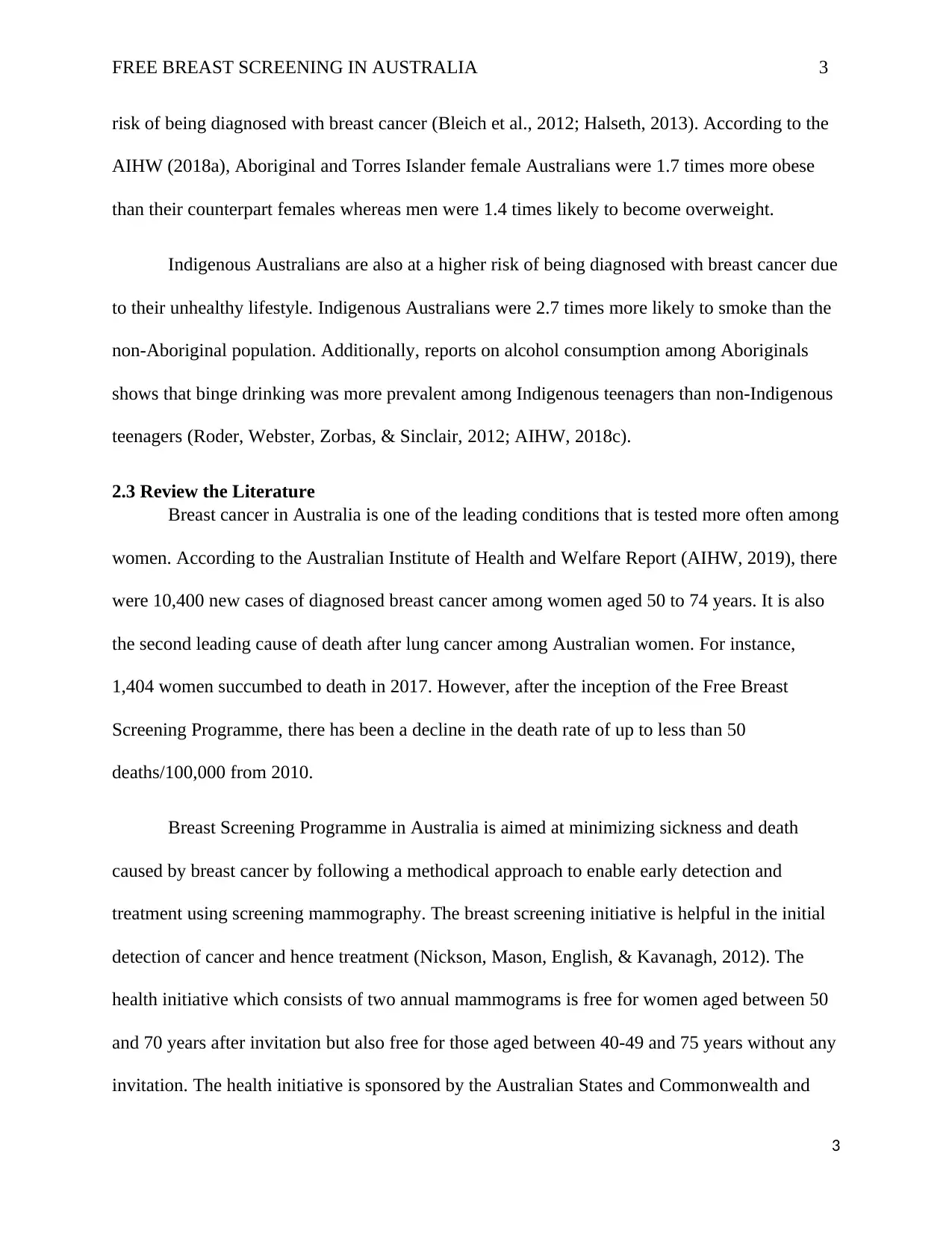
FREE BREAST SCREENING IN AUSTRALIA 3
risk of being diagnosed with breast cancer (Bleich et al., 2012; Halseth, 2013). According to the
AIHW (2018a), Aboriginal and Torres Islander female Australians were 1.7 times more obese
than their counterpart females whereas men were 1.4 times likely to become overweight.
Indigenous Australians are also at a higher risk of being diagnosed with breast cancer due
to their unhealthy lifestyle. Indigenous Australians were 2.7 times more likely to smoke than the
non-Aboriginal population. Additionally, reports on alcohol consumption among Aboriginals
shows that binge drinking was more prevalent among Indigenous teenagers than non-Indigenous
teenagers (Roder, Webster, Zorbas, & Sinclair, 2012; AIHW, 2018c).
2.3 Review the Literature
Breast cancer in Australia is one of the leading conditions that is tested more often among
women. According to the Australian Institute of Health and Welfare Report (AIHW, 2019), there
were 10,400 new cases of diagnosed breast cancer among women aged 50 to 74 years. It is also
the second leading cause of death after lung cancer among Australian women. For instance,
1,404 women succumbed to death in 2017. However, after the inception of the Free Breast
Screening Programme, there has been a decline in the death rate of up to less than 50
deaths/100,000 from 2010.
Breast Screening Programme in Australia is aimed at minimizing sickness and death
caused by breast cancer by following a methodical approach to enable early detection and
treatment using screening mammography. The breast screening initiative is helpful in the initial
detection of cancer and hence treatment (Nickson, Mason, English, & Kavanagh, 2012). The
health initiative which consists of two annual mammograms is free for women aged between 50
and 70 years after invitation but also free for those aged between 40-49 and 75 years without any
invitation. The health initiative is sponsored by the Australian States and Commonwealth and
3
risk of being diagnosed with breast cancer (Bleich et al., 2012; Halseth, 2013). According to the
AIHW (2018a), Aboriginal and Torres Islander female Australians were 1.7 times more obese
than their counterpart females whereas men were 1.4 times likely to become overweight.
Indigenous Australians are also at a higher risk of being diagnosed with breast cancer due
to their unhealthy lifestyle. Indigenous Australians were 2.7 times more likely to smoke than the
non-Aboriginal population. Additionally, reports on alcohol consumption among Aboriginals
shows that binge drinking was more prevalent among Indigenous teenagers than non-Indigenous
teenagers (Roder, Webster, Zorbas, & Sinclair, 2012; AIHW, 2018c).
2.3 Review the Literature
Breast cancer in Australia is one of the leading conditions that is tested more often among
women. According to the Australian Institute of Health and Welfare Report (AIHW, 2019), there
were 10,400 new cases of diagnosed breast cancer among women aged 50 to 74 years. It is also
the second leading cause of death after lung cancer among Australian women. For instance,
1,404 women succumbed to death in 2017. However, after the inception of the Free Breast
Screening Programme, there has been a decline in the death rate of up to less than 50
deaths/100,000 from 2010.
Breast Screening Programme in Australia is aimed at minimizing sickness and death
caused by breast cancer by following a methodical approach to enable early detection and
treatment using screening mammography. The breast screening initiative is helpful in the initial
detection of cancer and hence treatment (Nickson, Mason, English, & Kavanagh, 2012). The
health initiative which consists of two annual mammograms is free for women aged between 50
and 70 years after invitation but also free for those aged between 40-49 and 75 years without any
invitation. The health initiative is sponsored by the Australian States and Commonwealth and
3
⊘ This is a preview!⊘
Do you want full access?
Subscribe today to unlock all pages.

Trusted by 1+ million students worldwide
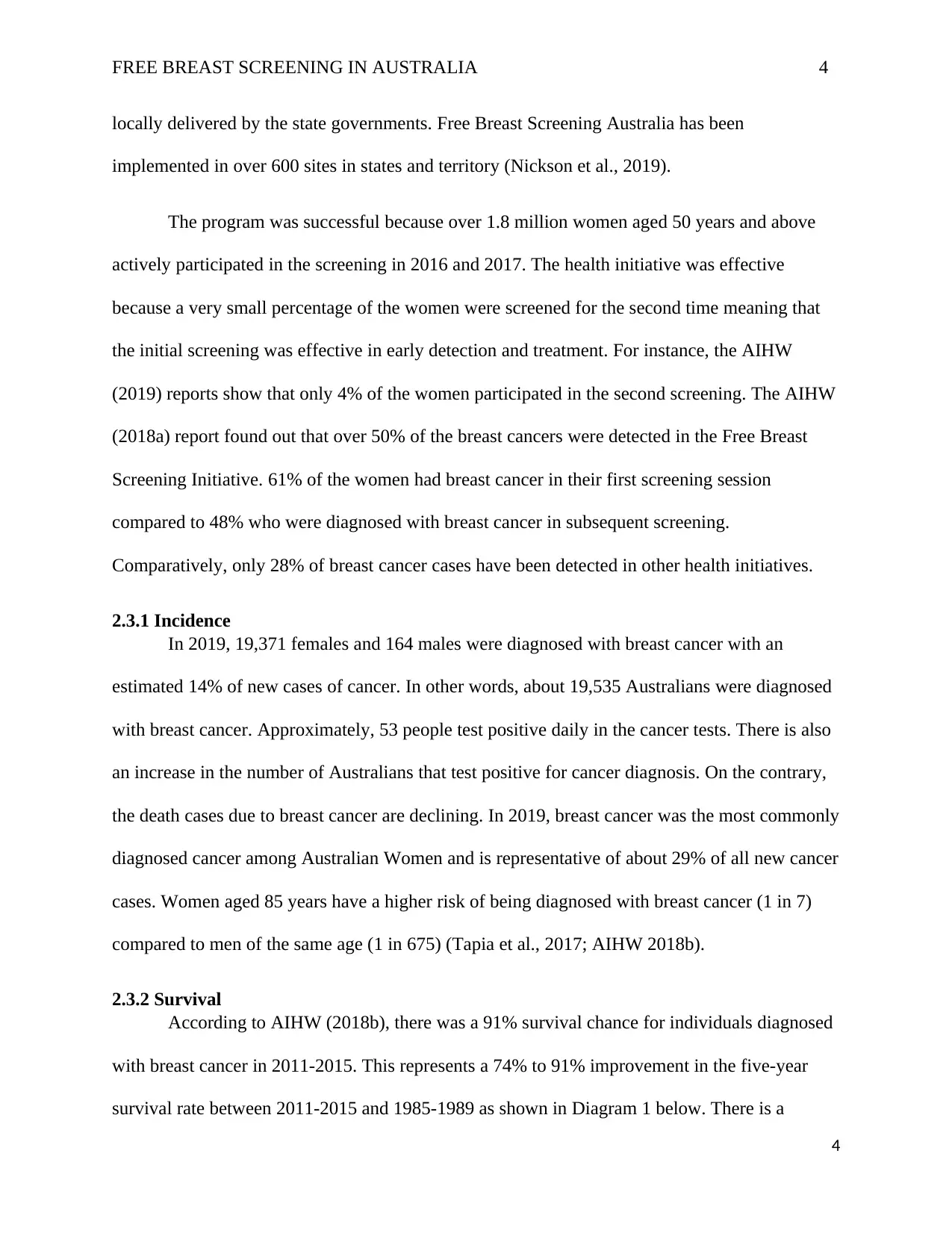
FREE BREAST SCREENING IN AUSTRALIA 4
locally delivered by the state governments. Free Breast Screening Australia has been
implemented in over 600 sites in states and territory (Nickson et al., 2019).
The program was successful because over 1.8 million women aged 50 years and above
actively participated in the screening in 2016 and 2017. The health initiative was effective
because a very small percentage of the women were screened for the second time meaning that
the initial screening was effective in early detection and treatment. For instance, the AIHW
(2019) reports show that only 4% of the women participated in the second screening. The AIHW
(2018a) report found out that over 50% of the breast cancers were detected in the Free Breast
Screening Initiative. 61% of the women had breast cancer in their first screening session
compared to 48% who were diagnosed with breast cancer in subsequent screening.
Comparatively, only 28% of breast cancer cases have been detected in other health initiatives.
2.3.1 Incidence
In 2019, 19,371 females and 164 males were diagnosed with breast cancer with an
estimated 14% of new cases of cancer. In other words, about 19,535 Australians were diagnosed
with breast cancer. Approximately, 53 people test positive daily in the cancer tests. There is also
an increase in the number of Australians that test positive for cancer diagnosis. On the contrary,
the death cases due to breast cancer are declining. In 2019, breast cancer was the most commonly
diagnosed cancer among Australian Women and is representative of about 29% of all new cancer
cases. Women aged 85 years have a higher risk of being diagnosed with breast cancer (1 in 7)
compared to men of the same age (1 in 675) (Tapia et al., 2017; AIHW 2018b).
2.3.2 Survival
According to AIHW (2018b), there was a 91% survival chance for individuals diagnosed
with breast cancer in 2011-2015. This represents a 74% to 91% improvement in the five-year
survival rate between 2011-2015 and 1985-1989 as shown in Diagram 1 below. There is a
4
locally delivered by the state governments. Free Breast Screening Australia has been
implemented in over 600 sites in states and territory (Nickson et al., 2019).
The program was successful because over 1.8 million women aged 50 years and above
actively participated in the screening in 2016 and 2017. The health initiative was effective
because a very small percentage of the women were screened for the second time meaning that
the initial screening was effective in early detection and treatment. For instance, the AIHW
(2019) reports show that only 4% of the women participated in the second screening. The AIHW
(2018a) report found out that over 50% of the breast cancers were detected in the Free Breast
Screening Initiative. 61% of the women had breast cancer in their first screening session
compared to 48% who were diagnosed with breast cancer in subsequent screening.
Comparatively, only 28% of breast cancer cases have been detected in other health initiatives.
2.3.1 Incidence
In 2019, 19,371 females and 164 males were diagnosed with breast cancer with an
estimated 14% of new cases of cancer. In other words, about 19,535 Australians were diagnosed
with breast cancer. Approximately, 53 people test positive daily in the cancer tests. There is also
an increase in the number of Australians that test positive for cancer diagnosis. On the contrary,
the death cases due to breast cancer are declining. In 2019, breast cancer was the most commonly
diagnosed cancer among Australian Women and is representative of about 29% of all new cancer
cases. Women aged 85 years have a higher risk of being diagnosed with breast cancer (1 in 7)
compared to men of the same age (1 in 675) (Tapia et al., 2017; AIHW 2018b).
2.3.2 Survival
According to AIHW (2018b), there was a 91% survival chance for individuals diagnosed
with breast cancer in 2011-2015. This represents a 74% to 91% improvement in the five-year
survival rate between 2011-2015 and 1985-1989 as shown in Diagram 1 below. There is a
4
Paraphrase This Document
Need a fresh take? Get an instant paraphrase of this document with our AI Paraphraser
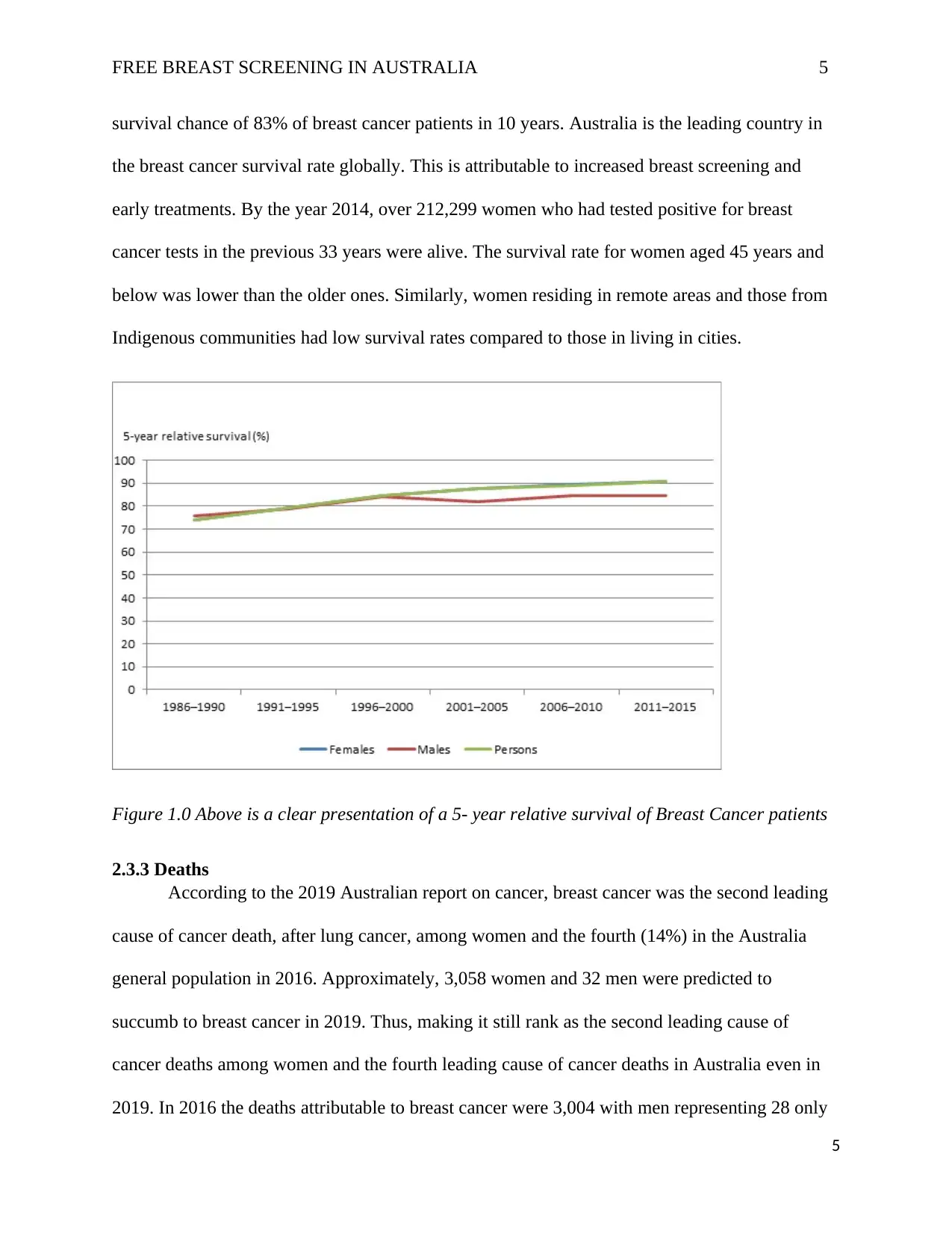
FREE BREAST SCREENING IN AUSTRALIA 5
survival chance of 83% of breast cancer patients in 10 years. Australia is the leading country in
the breast cancer survival rate globally. This is attributable to increased breast screening and
early treatments. By the year 2014, over 212,299 women who had tested positive for breast
cancer tests in the previous 33 years were alive. The survival rate for women aged 45 years and
below was lower than the older ones. Similarly, women residing in remote areas and those from
Indigenous communities had low survival rates compared to those in living in cities.
Figure 1.0 Above is a clear presentation of a 5- year relative survival of Breast Cancer patients
2.3.3 Deaths
According to the 2019 Australian report on cancer, breast cancer was the second leading
cause of cancer death, after lung cancer, among women and the fourth (14%) in the Australia
general population in 2016. Approximately, 3,058 women and 32 men were predicted to
succumb to breast cancer in 2019. Thus, making it still rank as the second leading cause of
cancer deaths among women and the fourth leading cause of cancer deaths in Australia even in
2019. In 2016 the deaths attributable to breast cancer were 3,004 with men representing 28 only
5
survival chance of 83% of breast cancer patients in 10 years. Australia is the leading country in
the breast cancer survival rate globally. This is attributable to increased breast screening and
early treatments. By the year 2014, over 212,299 women who had tested positive for breast
cancer tests in the previous 33 years were alive. The survival rate for women aged 45 years and
below was lower than the older ones. Similarly, women residing in remote areas and those from
Indigenous communities had low survival rates compared to those in living in cities.
Figure 1.0 Above is a clear presentation of a 5- year relative survival of Breast Cancer patients
2.3.3 Deaths
According to the 2019 Australian report on cancer, breast cancer was the second leading
cause of cancer death, after lung cancer, among women and the fourth (14%) in the Australia
general population in 2016. Approximately, 3,058 women and 32 men were predicted to
succumb to breast cancer in 2019. Thus, making it still rank as the second leading cause of
cancer deaths among women and the fourth leading cause of cancer deaths in Australia even in
2019. In 2016 the deaths attributable to breast cancer were 3,004 with men representing 28 only
5
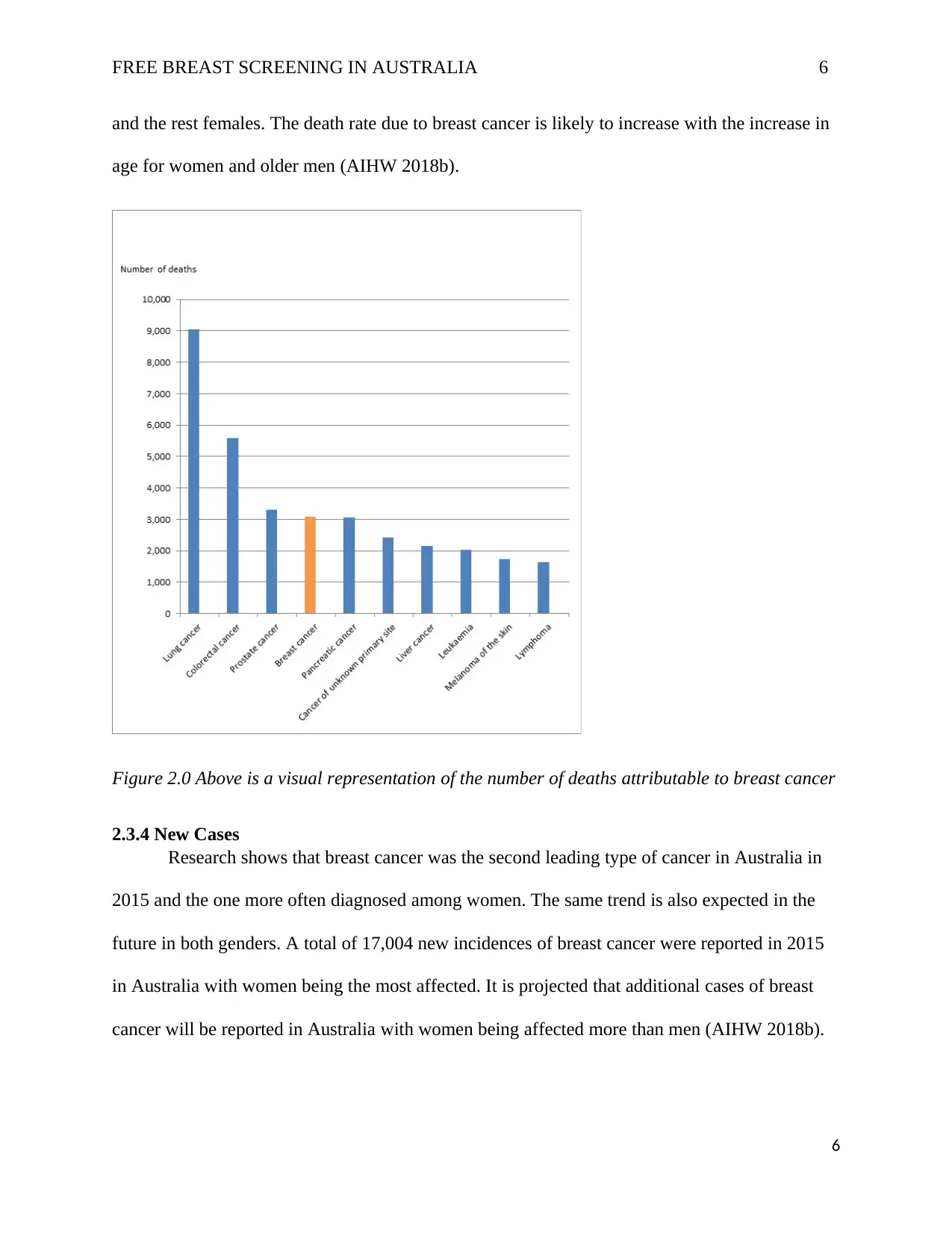
FREE BREAST SCREENING IN AUSTRALIA 6
and the rest females. The death rate due to breast cancer is likely to increase with the increase in
age for women and older men (AIHW 2018b).
Figure 2.0 Above is a visual representation of the number of deaths attributable to breast cancer
2.3.4 New Cases
Research shows that breast cancer was the second leading type of cancer in Australia in
2015 and the one more often diagnosed among women. The same trend is also expected in the
future in both genders. A total of 17,004 new incidences of breast cancer were reported in 2015
in Australia with women being the most affected. It is projected that additional cases of breast
cancer will be reported in Australia with women being affected more than men (AIHW 2018b).
6
and the rest females. The death rate due to breast cancer is likely to increase with the increase in
age for women and older men (AIHW 2018b).
Figure 2.0 Above is a visual representation of the number of deaths attributable to breast cancer
2.3.4 New Cases
Research shows that breast cancer was the second leading type of cancer in Australia in
2015 and the one more often diagnosed among women. The same trend is also expected in the
future in both genders. A total of 17,004 new incidences of breast cancer were reported in 2015
in Australia with women being the most affected. It is projected that additional cases of breast
cancer will be reported in Australia with women being affected more than men (AIHW 2018b).
6
⊘ This is a preview!⊘
Do you want full access?
Subscribe today to unlock all pages.

Trusted by 1+ million students worldwide
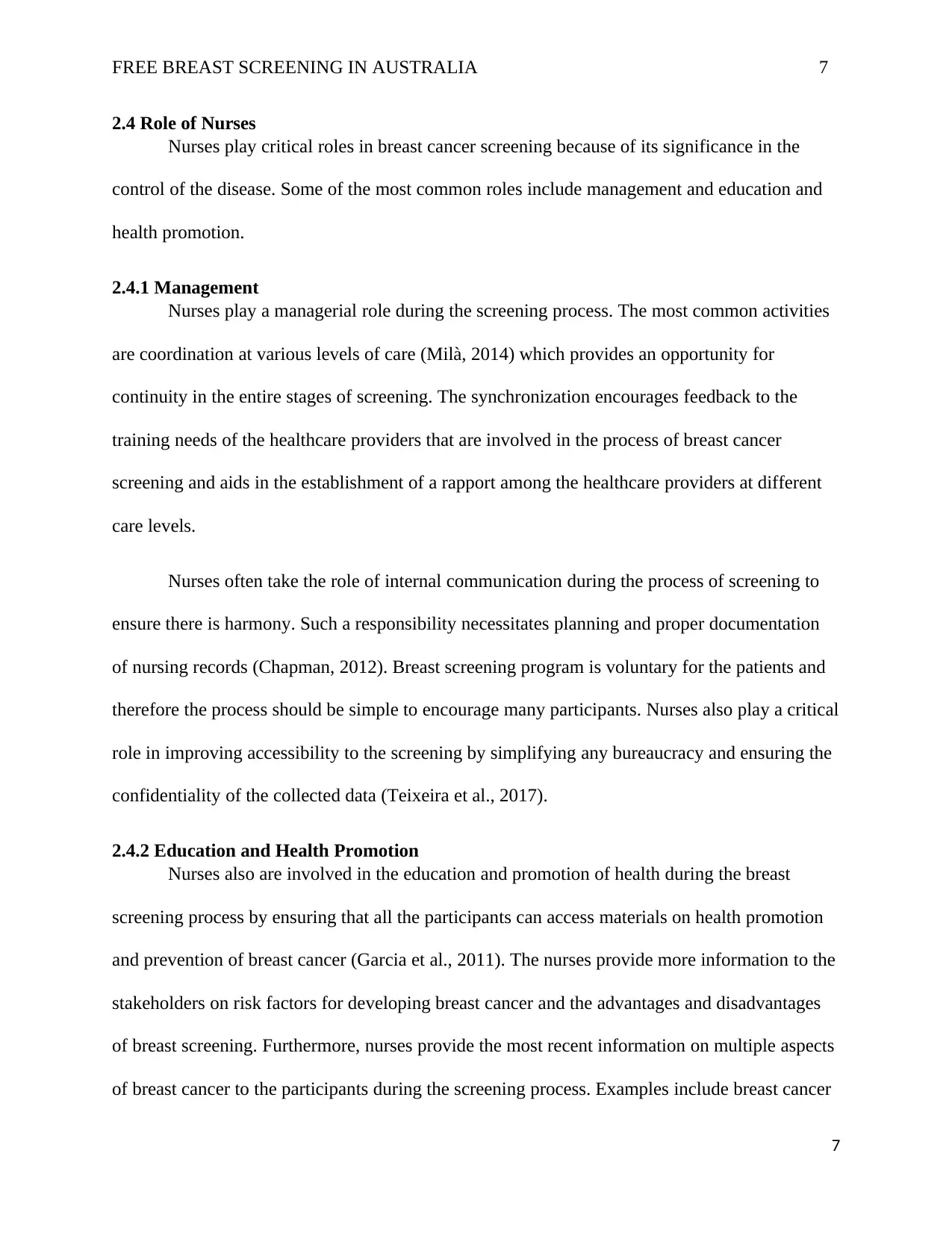
FREE BREAST SCREENING IN AUSTRALIA 7
2.4 Role of Nurses
Nurses play critical roles in breast cancer screening because of its significance in the
control of the disease. Some of the most common roles include management and education and
health promotion.
2.4.1 Management
Nurses play a managerial role during the screening process. The most common activities
are coordination at various levels of care (Milà, 2014) which provides an opportunity for
continuity in the entire stages of screening. The synchronization encourages feedback to the
training needs of the healthcare providers that are involved in the process of breast cancer
screening and aids in the establishment of a rapport among the healthcare providers at different
care levels.
Nurses often take the role of internal communication during the process of screening to
ensure there is harmony. Such a responsibility necessitates planning and proper documentation
of nursing records (Chapman, 2012). Breast screening program is voluntary for the patients and
therefore the process should be simple to encourage many participants. Nurses also play a critical
role in improving accessibility to the screening by simplifying any bureaucracy and ensuring the
confidentiality of the collected data (Teixeira et al., 2017).
2.4.2 Education and Health Promotion
Nurses also are involved in the education and promotion of health during the breast
screening process by ensuring that all the participants can access materials on health promotion
and prevention of breast cancer (Garcia et al., 2011). The nurses provide more information to the
stakeholders on risk factors for developing breast cancer and the advantages and disadvantages
of breast screening. Furthermore, nurses provide the most recent information on multiple aspects
of breast cancer to the participants during the screening process. Examples include breast cancer
7
2.4 Role of Nurses
Nurses play critical roles in breast cancer screening because of its significance in the
control of the disease. Some of the most common roles include management and education and
health promotion.
2.4.1 Management
Nurses play a managerial role during the screening process. The most common activities
are coordination at various levels of care (Milà, 2014) which provides an opportunity for
continuity in the entire stages of screening. The synchronization encourages feedback to the
training needs of the healthcare providers that are involved in the process of breast cancer
screening and aids in the establishment of a rapport among the healthcare providers at different
care levels.
Nurses often take the role of internal communication during the process of screening to
ensure there is harmony. Such a responsibility necessitates planning and proper documentation
of nursing records (Chapman, 2012). Breast screening program is voluntary for the patients and
therefore the process should be simple to encourage many participants. Nurses also play a critical
role in improving accessibility to the screening by simplifying any bureaucracy and ensuring the
confidentiality of the collected data (Teixeira et al., 2017).
2.4.2 Education and Health Promotion
Nurses also are involved in the education and promotion of health during the breast
screening process by ensuring that all the participants can access materials on health promotion
and prevention of breast cancer (Garcia et al., 2011). The nurses provide more information to the
stakeholders on risk factors for developing breast cancer and the advantages and disadvantages
of breast screening. Furthermore, nurses provide the most recent information on multiple aspects
of breast cancer to the participants during the screening process. Examples include breast cancer
7
Paraphrase This Document
Need a fresh take? Get an instant paraphrase of this document with our AI Paraphraser
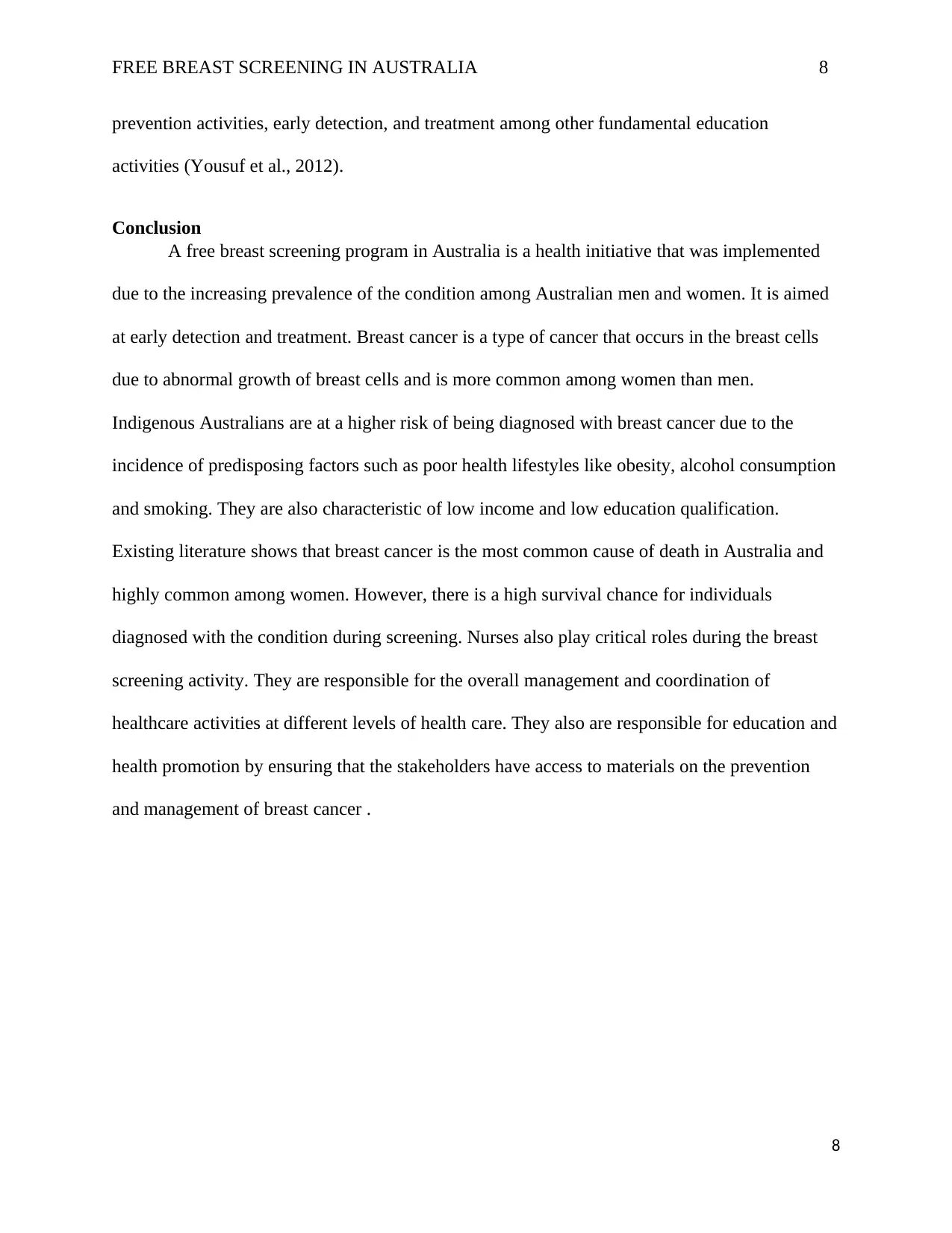
FREE BREAST SCREENING IN AUSTRALIA 8
prevention activities, early detection, and treatment among other fundamental education
activities (Yousuf et al., 2012).
Conclusion
A free breast screening program in Australia is a health initiative that was implemented
due to the increasing prevalence of the condition among Australian men and women. It is aimed
at early detection and treatment. Breast cancer is a type of cancer that occurs in the breast cells
due to abnormal growth of breast cells and is more common among women than men.
Indigenous Australians are at a higher risk of being diagnosed with breast cancer due to the
incidence of predisposing factors such as poor health lifestyles like obesity, alcohol consumption
and smoking. They are also characteristic of low income and low education qualification.
Existing literature shows that breast cancer is the most common cause of death in Australia and
highly common among women. However, there is a high survival chance for individuals
diagnosed with the condition during screening. Nurses also play critical roles during the breast
screening activity. They are responsible for the overall management and coordination of
healthcare activities at different levels of health care. They also are responsible for education and
health promotion by ensuring that the stakeholders have access to materials on the prevention
and management of breast cancer .
8
prevention activities, early detection, and treatment among other fundamental education
activities (Yousuf et al., 2012).
Conclusion
A free breast screening program in Australia is a health initiative that was implemented
due to the increasing prevalence of the condition among Australian men and women. It is aimed
at early detection and treatment. Breast cancer is a type of cancer that occurs in the breast cells
due to abnormal growth of breast cells and is more common among women than men.
Indigenous Australians are at a higher risk of being diagnosed with breast cancer due to the
incidence of predisposing factors such as poor health lifestyles like obesity, alcohol consumption
and smoking. They are also characteristic of low income and low education qualification.
Existing literature shows that breast cancer is the most common cause of death in Australia and
highly common among women. However, there is a high survival chance for individuals
diagnosed with the condition during screening. Nurses also play critical roles during the breast
screening activity. They are responsible for the overall management and coordination of
healthcare activities at different levels of health care. They also are responsible for education and
health promotion by ensuring that the stakeholders have access to materials on the prevention
and management of breast cancer .
8
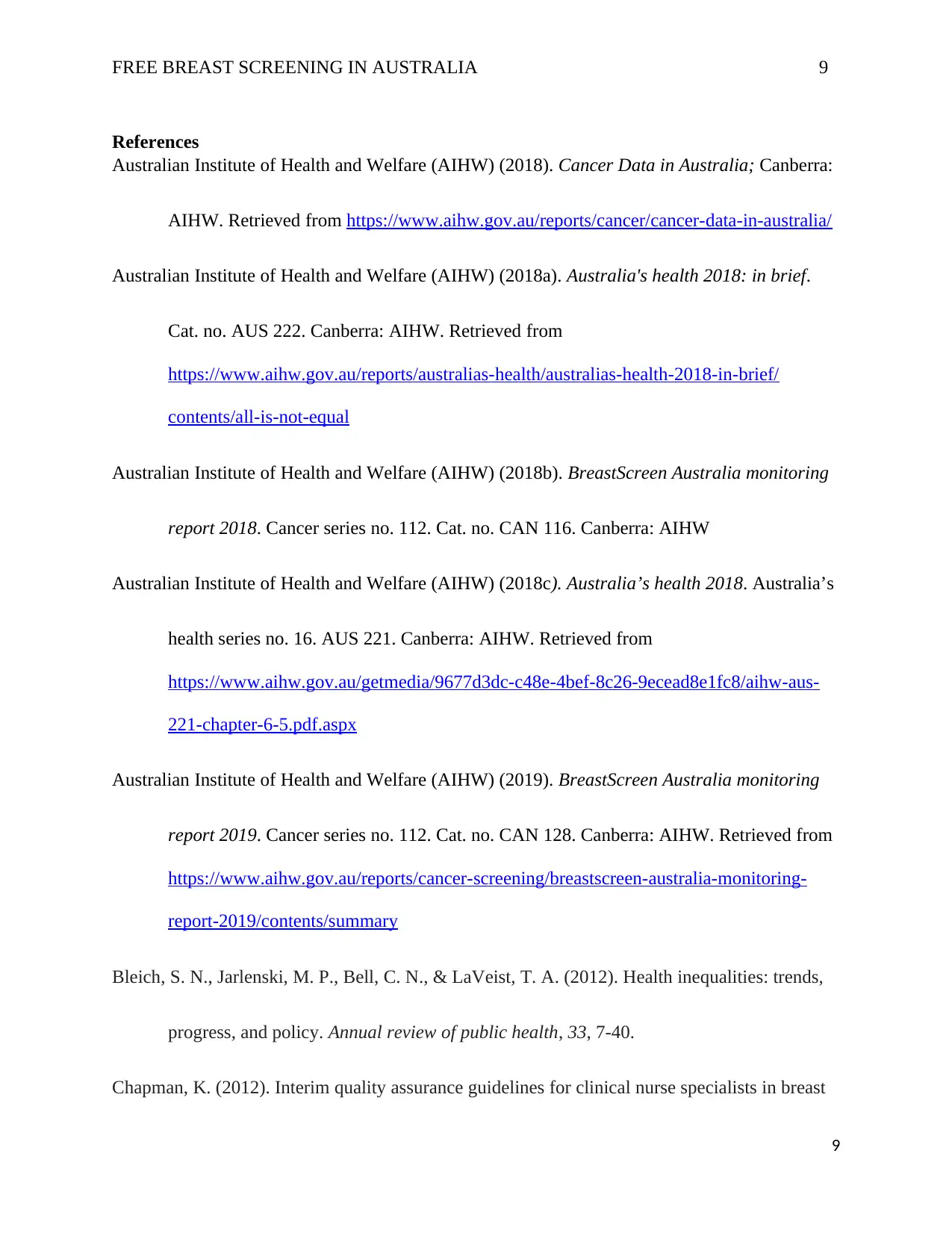
FREE BREAST SCREENING IN AUSTRALIA 9
References
Australian Institute of Health and Welfare (AIHW) (2018). Cancer Data in Australia; Canberra:
AIHW. Retrieved from https://www.aihw.gov.au/reports/cancer/cancer-data-in-australia/
Australian Institute of Health and Welfare (AIHW) (2018a). Australia's health 2018: in brief.
Cat. no. AUS 222. Canberra: AIHW. Retrieved from
https://www.aihw.gov.au/reports/australias-health/australias-health-2018-in-brief/
contents/all-is-not-equal
Australian Institute of Health and Welfare (AIHW) (2018b). BreastScreen Australia monitoring
report 2018. Cancer series no. 112. Cat. no. CAN 116. Canberra: AIHW
Australian Institute of Health and Welfare (AIHW) (2018c). Australia’s health 2018. Australia’s
health series no. 16. AUS 221. Canberra: AIHW. Retrieved from
https://www.aihw.gov.au/getmedia/9677d3dc-c48e-4bef-8c26-9ecead8e1fc8/aihw-aus-
221-chapter-6-5.pdf.aspx
Australian Institute of Health and Welfare (AIHW) (2019). BreastScreen Australia monitoring
report 2019. Cancer series no. 112. Cat. no. CAN 128. Canberra: AIHW. Retrieved from
https://www.aihw.gov.au/reports/cancer-screening/breastscreen-australia-monitoring-
report-2019/contents/summary
Bleich, S. N., Jarlenski, M. P., Bell, C. N., & LaVeist, T. A. (2012). Health inequalities: trends,
progress, and policy. Annual review of public health, 33, 7-40.
Chapman, K. (2012). Interim quality assurance guidelines for clinical nurse specialists in breast
9
References
Australian Institute of Health and Welfare (AIHW) (2018). Cancer Data in Australia; Canberra:
AIHW. Retrieved from https://www.aihw.gov.au/reports/cancer/cancer-data-in-australia/
Australian Institute of Health and Welfare (AIHW) (2018a). Australia's health 2018: in brief.
Cat. no. AUS 222. Canberra: AIHW. Retrieved from
https://www.aihw.gov.au/reports/australias-health/australias-health-2018-in-brief/
contents/all-is-not-equal
Australian Institute of Health and Welfare (AIHW) (2018b). BreastScreen Australia monitoring
report 2018. Cancer series no. 112. Cat. no. CAN 116. Canberra: AIHW
Australian Institute of Health and Welfare (AIHW) (2018c). Australia’s health 2018. Australia’s
health series no. 16. AUS 221. Canberra: AIHW. Retrieved from
https://www.aihw.gov.au/getmedia/9677d3dc-c48e-4bef-8c26-9ecead8e1fc8/aihw-aus-
221-chapter-6-5.pdf.aspx
Australian Institute of Health and Welfare (AIHW) (2019). BreastScreen Australia monitoring
report 2019. Cancer series no. 112. Cat. no. CAN 128. Canberra: AIHW. Retrieved from
https://www.aihw.gov.au/reports/cancer-screening/breastscreen-australia-monitoring-
report-2019/contents/summary
Bleich, S. N., Jarlenski, M. P., Bell, C. N., & LaVeist, T. A. (2012). Health inequalities: trends,
progress, and policy. Annual review of public health, 33, 7-40.
Chapman, K. (2012). Interim quality assurance guidelines for clinical nurse specialists in breast
9
⊘ This is a preview!⊘
Do you want full access?
Subscribe today to unlock all pages.

Trusted by 1+ million students worldwide
1 out of 14
Related Documents
Your All-in-One AI-Powered Toolkit for Academic Success.
+13062052269
info@desklib.com
Available 24*7 on WhatsApp / Email
![[object Object]](/_next/static/media/star-bottom.7253800d.svg)
Unlock your academic potential
Copyright © 2020–2025 A2Z Services. All Rights Reserved. Developed and managed by ZUCOL.





